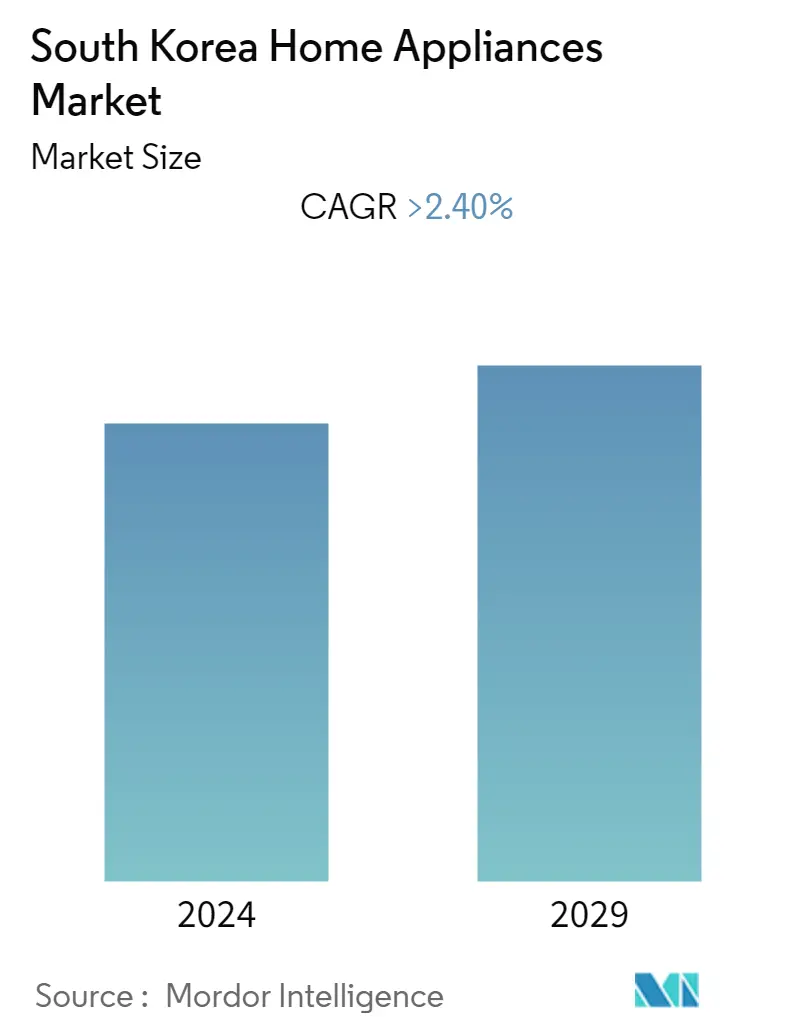Market Size of South Korea Home Appliances Industry

| Study Period | 2020 - 2029 |
| Base Year For Estimation | 2023 |
| Forecast Data Period | 2024 - 2029 |
| Historical Data Period | 2020 - 2022 |
| CAGR | 2.40 % |
Major Players.webp)
*Disclaimer: Major Players sorted in no particular order |
South Korean Home Appliances Market Analysis
A technology-driven country, South Korea, holds greater scope for the home appliances market. The majority of the existing technology innovations were first introduced in the South Korean market to match the dynamically changing consumer preferences. The electronics giants, like LG Electronics and Samsung, are retaining their global top positions by addressing these customer preferences in a timely manner. The market for major home appliances is greater than that of the small home appliances in this region. Technology up-gradation and the adoptability it holds for applications in every segment of the home appliance are making the market an evergreen one for manufacturers. Despite being a developed country with saturated market conditions, the South Korean home appliances market still holds the power to penetrate and grab a positive market share. This astronomical change that is being observed is due to the increased disposable incomes of people and the rapid urbanization trends that can be seen in different parts of the country. Large home appliances are still scoring a positive number when compared to small home appliances.
COVID-19 had a mixed impact on retail volume sales in the South Korean home appliances market in 2020, thus, significantly boosting the demand for coffee machines, coffee mills, and breadmakers. On the other hand, the pandemic may have a modest negative impact on the demand for light fryers and rice cookers.
South Korean Home Appliances Industry Segmentation
A complete background analysis of the South Korean home appliances industry, which includes an assessment of the industry associations, overall economy, and emerging market trends by segments, significant changes in the market dynamics, and market overview, is covered in the report.
| Major Appliances | |
| Refrigerators | |
| Freezers | |
| Dishwashing Machines | |
| Washing Machines | |
| Cookers and Ovens |
| Small Appliances | |
| Vacuum Cleaners | |
| Toasters | |
| Grills and Roasters | |
| Coffee/Tea Makers | |
| Mixers and Grinders | |
| Other Appliances |
| Distribution Channel | |
| Supermarkets and Hypermarkets | |
| Specialty Stores | |
| E-commerce | |
| Other Distribution Channels |
South Korea Home Appliances Market Size Summary
The South Korean home appliances industry is characterized by its technology-driven landscape, with major players like LG Electronics and Samsung Electronics leading the market by swiftly adapting to evolving consumer preferences. The market for major home appliances surpasses that of small appliances, driven by continuous technological advancements and the integration of IoT and AI functionalities. Despite being a developed and saturated market, the industry continues to expand, fueled by rising disposable incomes and rapid urbanization. The COVID-19 pandemic had a mixed impact on the market, boosting demand for certain appliances while modestly affecting others. The concept of smart homes and the increasing popularity of built-in appliances are key trends shaping consumer demand, alongside innovations like LG's Home Chat app, which enhances connectivity and monitoring of home appliances.
The market is also witnessing a rise in sales of small kitchen appliances, driven by their convenience in reducing time spent on household tasks. Air purifiers are expected to gain significant market share due to concerns over air quality and health issues related to respiratory conditions. The industry is supported by major international players, with LG Electronics and Samsung Electronics performing strongly in their home market. Strategic partnerships, such as those between LG and Magna International, and Samsung and Q CELLS, highlight the industry's focus on innovation and energy efficiency, aiming to create solutions like zero energy homes. These collaborations underscore the commitment to integrating advanced technologies and sustainable practices in the home appliances sector.
South Korea Home Appliances Market Size - Table of Contents
-
1. MARKET INSIGHTS AND DYNAMICS
-
1.1 Market Overview
-
1.2 Market Drivers
-
1.3 Market Restraints
-
1.4 Value Chain Analysis
-
1.5 Porter's Five Forces Analysis
-
1.5.1 Threat of New Entrants
-
1.5.2 Bargaining Power of Buyers/Consumers
-
1.5.3 Bargaining Power of Suppliers
-
1.5.4 Threat of Substitute Products
-
1.5.5 Intensity of Competitive Rivalry
-
-
1.6 Technological Innovations
-
1.7 Impact of COVID-19 on the Market
-
-
2. MARKET SEGMENTATION
-
2.1 Major Appliances
-
2.1.1 Refrigerators
-
2.1.2 Freezers
-
2.1.3 Dishwashing Machines
-
2.1.4 Washing Machines
-
2.1.5 Cookers and Ovens
-
-
2.2 Small Appliances
-
2.2.1 Vacuum Cleaners
-
2.2.2 Toasters
-
2.2.3 Grills and Roasters
-
2.2.4 Coffee/Tea Makers
-
2.2.5 Mixers and Grinders
-
2.2.6 Other Appliances
-
-
2.3 Distribution Channel
-
2.3.1 Supermarkets and Hypermarkets
-
2.3.2 Specialty Stores
-
2.3.3 E-commerce
-
2.3.4 Other Distribution Channels
-
-
South Korea Home Appliances Market Size FAQs
What is the current South Korea Home Appliances Market size?
The South Korea Home Appliances Market is projected to register a CAGR of greater than 2.40% during the forecast period (2024-2029)
Who are the key players in South Korea Home Appliances Market?
LG Electronics, Samsung Electronics, Whirlpool Corporation, Panasonic Corporation and Haier Electronics Group Co. Ltd, are the major companies operating in the South Korea Home Appliances Market.

